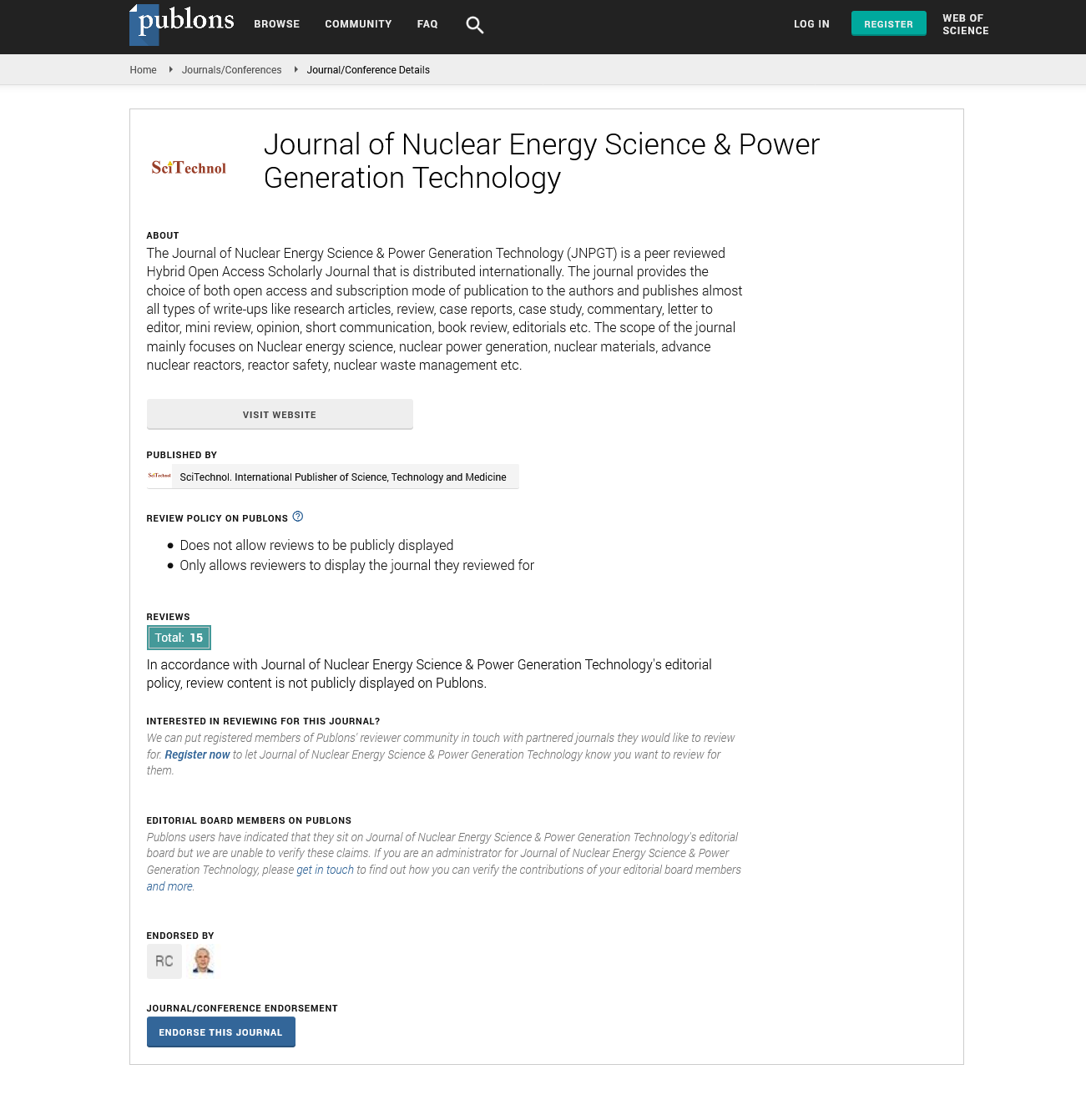Short Communication, J Nucl Ene Sci Power Generat Technol Vol: 13 Issue: 2
Significance of Water Turbines its types and Applications in Sustainable Energy Production
Moadhum Aboaltab*
1Department of Technical Power Mechanics, Najaf Al-Furat Al-Awast Technical University, Najaf, Iraq
*Corresponding Author: Moadhum Aboaltab,
Department of Technical Power
Mechanics, Najaf Al-Furat Al-Awast Technical University, Najaf, Iraq
E-mail: moadhum_1aboaltab@gmail.com
Received date: 13 February, 2024, Manuscript No. JNPGT-24-133574;
Editor assigned date: 15 February, 2024, PreQC No. JNPGT-24-133574 (PQ);
Reviewed date: 29 February, 2024, QC No. JNPGT-24-133574;
Revised date: 07 March, 2024, Manuscript No. JNPGT-24-133574 (R);
Published date: 15 March, 2024, DOI: 10.4172/2325-9809.1000391.
Citation: Aboaltab M (2024) Significance of Water Turbines its types and Applications in Sustainable Energy Production. J Nucl Ene Sci Power Generat
Technol 13:2.
Description
Water turbines stand as iconic symbols of harnessing nature's energy to generate clean and renewable electricity. Utilizing the kinetic energy of flowing water, these devices have played a pivotal role in powering communities, industries, and economies for centuries the mechanics, types, applications, and environmental significance of water turbines, exploring how they continue to shape the landscape of sustainable energy production. Water turbines are mechanical devices designed to convert the energy of flowing water into rotational mechanical energy, which can then be used to drive generators and produce electricity [1].
They operate on the principle of hydrodynamics, exploiting the kinetic energy of water in motion to perform useful work. Water turbines consist of several essential components, including blades or buckets, a rotor, a shaft, and a generator. The blades or buckets are positioned in the path of the flowing water and are designed to capture the energy of the water's movement [2-5]. As the water flows over the blades, it imparts a force that causes the rotor to rotate. The rotating rotor is connected to a shaft, which, in turn, drives a generator to produce electricity. There are various types of water turbines, each suited to different flow conditions and applications.
Ideal for high-head, low-flow conditions, Pelton turbines feature spoon-shaped buckets arranged around a circular rotor. Water jets from nozzles strike the buckets, causing the rotor to spin. Suitable for medium to low-head conditions, Francis turbines feature curved blades that allow them to operate efficiently across a wide range of flow rates and heads [6-8]. Designed for low-head, high-flow conditions, Kaplan turbines feature adjustable blades that can be pitched to optimize performance under varying flow conditions. Water turbines are employed in a diverse range of applications, from smallscale hydroelectric projects to large-scale power plants. They are particularly well-suited for generating electricity from hydropower resources, including rivers, streams, and dams. Small-scale hydroelectric systems can provide decentralized power generation for remote communities or off-grid locations, while large-scale hydroelectric plants contribute significantly to grid stability and energy supply. In addition to electricity generation, water turbines are utilized in various industrial applications, such as water pumping, water desalination, and wastewater treatment [9].
They also play an important role in agricultural irrigation systems, where they help distribute water efficiently to farmland. One of the most significant advantages of water turbines is their environmental sustainability. Unlike fossil fuel-based power generation, which produces greenhouse gas emissions and contributes to air and water pollution, hydroelectric power generation emits minimal pollutants and has a low carbon footprint. Furthermore, hydroelectric reservoirs can serve additional functions, such as flood control, water supply, and recreational activities, enhancing their overall environmental and societal benefits. Moreover, water turbines contribute to energy security by providing a reliable source of renewable energy that is not subject to fuel price volatility or supply disruptions [10].
Conclusion
Water turbines epitomize the synergy between human skill and the forces of nature, providing a sustainable and reliable source of clean energy. As the world transitions towards low-carbon future, water turbines will continue to play an important role in meeting the growing demand for electricity while moderating the environmental impacts of energy production. By embracing technological advancements and investing in hydroelectric infrastructure, can unlock the full potential of water turbines and pave the way for a greener and more sustainable energy landscape. Their long operational lifespan and low maintenance requirements make them a cost-effective and dependable energy solution in the long term.
References
- Casamirra M, Castiglia F, Giardina M, Lombardo C, Celata GP et al. (2005) Rewetting of a hot vertical surface by liquid sprays. Exp Therm Fluid Sci 29:885-891.
- Cheng SC, Lau PWK, Poon KT (1985) Measurements of true quench temperature of subcooled water under forced convective conditions. Int J Heat Mass Transf 28:235-243.
- Roth GA, Aydogan F (2014) Theory and implementation of nuclear safety system codes-Part II: System code closure relations, validation and limitations. Prog Nucl Energy 76:55-72.
- Karwa N, Gambaryan-Roisman T, Stephan P, Tropea C (2011) Experimental investigation of circular free surface jet impingement quenching: Transient hydrodynamics and heat transfer. Exp Therm Fluid Sci 35:1435-1443.
- Bogdanic L, Auracher H, Ziegler F (2009) Two phase structure above hot surfaces in jet impingement boiling. Heat Mass Transf 45:1019-1028.
- Islam MA, Monde M, Woodfield PL, Mitsutake Y (2008) Jet impingement quenching phenomena for hot surfaces well above the limiting temperature for solid liquid contact. Int J Heat Mass Transf 51:1226-1237.
- Carbajo JJ (1985) A study on the rewetting temperature. Nucl Eng Des 84:21-52.
- Fang X, Chen Y, Zhang H, Chen W, Dong A et al. (2016) Heat transfer and critical heat flux of nano fluid boiling : A comprehensive review. Renew Sust Energ Rev 62:924-940.
- Filipovic J, Incropera FP, Viskanta R (1995) Rewetting temperatures and velocity in a quenching experiment. Exp Heat Transf 8:257-270.
- Mozumder AK, Monde M, Woodfield PL, Islam MA (2006) Maximum heat flux in relation to quenching of a high temperature surface with liquid jet impingement. Int J Heat Mass Transf 49:2877-2888.
 Spanish
Spanish  Chinese
Chinese  Russian
Russian  German
German  French
French  Japanese
Japanese  Portuguese
Portuguese  Hindi
Hindi 

